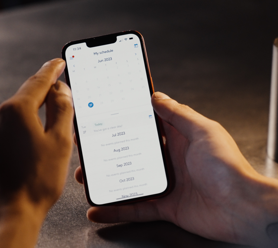
Care Home Activity Planner – What is it?
A care home activity planner is a tool or document used to organise and schedule recreational and therapeutic activities for residents in a care home.
With the purpose of the planner to enhance the quality of life of residents, it’s an important asset to have to provide engaging and meaningful activities that cater to every interest, need, and ability.
What are the key components of a care home activity planner?

Whilst having an activity planner in your care home is important, for it to serve its purpose, care homes need to know what should be included. Below is a list of the key components that your care home should consider including in your activity planner:
-
Activity Schedule - One of the most important elements of the planner is an activity schedule. This could include both a daily and weekly plan or calendar outlining the activities planned for each day of the week.
Within the activity schedule, you should include key information including the times and location of each activity. That way you can reduce anxiety in your residents as well as ensure there is a mixture of activities to appeal to every need and preference throughout the day.
-
Activity Types - The second key component of the planner is including information about the activities offered.
There should be a good variety of recreational activities including:
- games
- arts
- crafts
- music sessions
Therapeutic activities should focus on:
- physical
- emotional
- cognitive stimulation such as sensory activities or exercise classes
It is also important to have a combination of social group activities like movie nights to encourage social interaction as well as individual activities like:
- reading
- puzzle-solving
- or one-on-one chats with staff
By having a variety of activities available you can easily cater to every need as well as make activities more accessible to individuals who may be more anxious to join in.
-
Staff Responsibilities - Whilst it is important to know when care activities are on every day in your care home, it is also important for all care staff to know and understand their responsibilities during that time.
For example, who will lead or facilitate each activity, and whether care staff are trained and prepared to conduct the activities effectively and safely.
-
Resources and Materials - Another key component of the activity planner is understanding if you have the resources and materials needed for each activity.
By having a list of the materials needed you can have a better track and stock management of the resources you have and need to ensure that you do not go over budget.
-
Compliance and Documentation - To keep both care staff and your care home residents safe the activity planner should also include any important documentation to ensure that activities align with regulatory standards and best practices for care homes.
Records of activities conducted, their attendance, any notable outcomes or resident responses can all be recorded in the activity planner. That way you can see which activities are popular and most beneficial for your residents, whilst listening to what their preferences are.
-
Feedback - One of the final components that should be included in your care home activity planner is your resident’s feedback. Collecting this feedback helps your care home staff to refine and improve the activity plan.
Regular assessments of the effectiveness of activities are also vital to help you measure the impact they have on residents’ wellbeing.
Why are care home activity planners important?
Care home activity planners play a crucial role in enhancing the quality of life for your residents. When organised and managed successfully it can offer several different benefits, improving the day-to-day running of your home, your residents’ wellbeing, and the delivery of care your care staff provides.
Below is a list of some of the other reasons activity planners are important in care homes:
- Stimulates cognitive function
- Promotes physical health
- Encourages social interaction
- Supports emotional wellbeing
- Increases independence and confidence
- Creates a sense of routine
- Tailors to individual needs
- Provides meaningful engagement
- Enhances quality of life
- Improves health outcomes
Best ways to implement a care home activity planner
Implementing an effective care home activity planner involves several key steps to ensure activities are engaging, beneficial, and tailored to the resident’s needs.
Here are 8 key steps to ensure your activity planner works and is successful:
-
Assess Residents’ Needs and Preferences - To know what care home activities residents want you need to talk to them, their families, and staff to understand their interests, hobbies, and preferences.
Considering past activities is normally a good first step as they can be tailored to the care home residents you have now.
-
Develop a Diverse Activity Schedule - As mentioned above, it is vital that all activities meet the diverse needs and wants of your care home residents.
Ensure you offer a mix of physical, cognitive, creative, and social activities whilst offering a balance of both group and solo activities too.
-
Set Clear Goals and Objectives - When creating the activity planner, make sure you and your care staff know what you hope to achieve with each activity.
That way when you track attendance and gain feedback to easily identify if that activity has been effective or not and adjust it if needed.
-
Engage and Train Staff - For activities to run smoothly your care home staff must know how to facilitate these activities to recognise residents’ needs and encourage participation.
Creating a collaborative environment where staff can contribute ideas and support each other in delivering activities enables everyone involved to experience the benefits.
-
Involve Residents in Planning - When creating your care home activity planner residents' voices must be heard, otherwise, you are at risk of arranging activities that your residents are not interested in.
Make sure you allow residents to choose from a range of activities to promote engagement and inclusivity.
-
Adapt Activities for Accessibility - To ensure all residents can get involved, adjust activities to accommodate different physical and cognitive abilities ensuring everyone can participate meaningfully.
Carry out risk assessments so you can plan how you can mitigate risks to ensure everyone involved in the activity is safe and enjoys it.
Sometimes this will include not only having a member of your care staff facilitating the activity but also additional care professionals helping support residents to complete it too, especially if it’s an activity with external companies or presenters.
-
Schedule both Regular and Special Events - Whilst having daily and weekly activities that run regularly is important to create structure, routines, and consistency, it is also important to plan occasional and special events. For example, a party to celebrate a resident’s birthday creates variety, excitement, and a sense of belonging.
-
Evaluate and Adjust - Always gather feedback to see what works and what doesn’t for your care home residents. During this time, you can also review any additional safety protocols and procedures needed to ensure all activities are accessible as more or less residents or new residents want to join in on an activity.
In general, Care home activity planners should be reviewed monthly for feedback and seasonal updates, quarterly to reassess resident needs and resources, and annually for a comprehensive evaluation.
More specifically each care home, should also be reviewed as needed in response to significant changes to ensure activities remain effective and aligned with residents’ needs and care home goals.
By thoughtfully implementing these strategies, you can create a dynamic and supportive environment that enhances the wellbeing and quality of life for all your care home residents.

Care Home Activity Planner Template
As we have discussed above there is a lot of information that can be added to a care home activity planner.
The size of your care home will determine the scope of your activity planner, which can be as detailed or streamlined as needed. However, it doesn't have to be complicated. With our implementation tips, the care home activity planner below is easily adaptable to suit the specific needs of your care home.
Care Home Activity Planner
Week of: [Insert Date]
|
Day |
Morning Activity (9:00 AM - 12:00 PM) |
Afternoon Activity (1:00 PM - 4:00 PM) |
Evening Activity (6:00 PM - 8:00 PM) |
Notes/Staff Assigned |
|
Monday |
Gentle Exercise & Stretching |
Arts & Crafts |
Movie Night |
- Monitor mobility needs during exercises. |
|
Tuesday |
Memory Games & Puzzles |
Gardening Club |
Board Games |
- Provide assistance for residents with cognitive difficulties. |
|
Wednesday |
Music Therapy |
Cooking/Baking Class |
Storytelling |
- Prepare song playlists or lyrics sheets. |
|
Thursday |
Chair Aerobics |
Art Appreciation |
Puzzle Night |
- Ensure space is clear for chair aerobics. |
|
Friday |
Outdoor Walks |
Pet Therapy |
Karaoke Night |
- Monitor weather conditions for outdoor activities. |
|
Saturday |
Creative Writing |
Craft Workshop |
Game Night |
- Provide writing materials and prompts. |
|
Sunday |
Religious/Spiritual Services |
Book Club |
Relaxation & Meditation |
- Coordinate with local religious organizations if needed. |
Weekly Themes/Events:
- Monthly Birthday Celebration: [Insert Date]
- Special Event: [Insert Event, e.g., "Summer BBQ" on [Insert Date]]
- Resident of the Month: [Insert Name]
Notes:
- Activity Goals: Ensure that activities cater to physical, cognitive, emotional, and social needs.
- Resident Involvement: Encourage residents to participate in planning or suggesting activities.
- Adaptability: Be prepared to modify activities based on residents' moods, health, or preferences on the day.
Summarising the importance of care home activity planners
In conclusion, care home activity planners are essential tools for enhancing the quality of life for residents while ensuring the smooth operations of your care home.
This article has explained the key features of an activity planner and the best ways to implement it to keep care residents and care staff happy and safe as well as ensure resident voices are heard.
By organising and managing activities that stimulate cognitive function, promote physical health, encourage social interaction, and support emotional wellbeing, these planners help create a structured environment that meets the diverse needs of residents.
Here an effective activity planner not only fosters a sense of routine and engagement but also contributes to improved health outcomes and overall resident satisfaction.
At The Access Group, we understand the importance of maintaining a safe, efficient, and compliant care home.
Our care home software is designed to help you manage every aspect of your operations, including care planning, care compliance, and activity planning, to ensure you deliver better person-centred care that is tailored to every resident.
Access Care and Clinical for example, can help identify which activities would best suit your care home residents. Through looking at their individual profile notes you can identify their medical conditions to determine their mobility and cognitive ability for certain activities, as well as if their mood changing is the reason that their attendance in activities has dropped.
With our Access Medication Management, best risk assessment can be conducted by understand what medications are administered for your care home residents throughout the day and what side effects that causes them, for example dizziness which could influence their participation in activities planned. As a result, schedules can be planned to avoid individuals missing out on activities they want to do.
To learn more about how our care home software can support your home, whilst ensuring your residents and staff remain happy and safe, contact us today.

